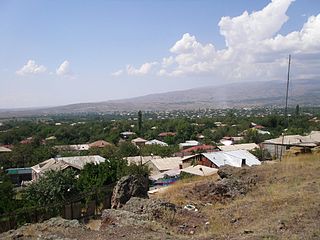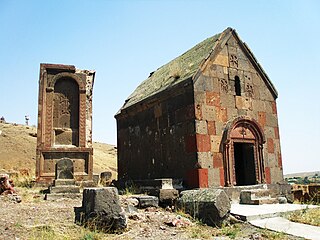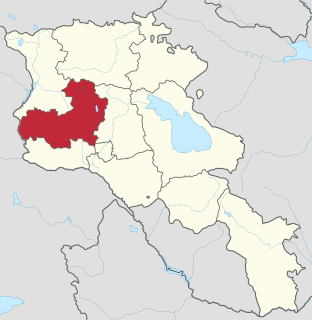
Aragatsotn is a province (marz) of Armenia. It is located in the western part of the country. The capital and largest city of the province is the town of Ashtarak. The National Statistical Service of the Republic of Armenia (ARMSTAT) reported its population was 132,925 in the 2011 census.
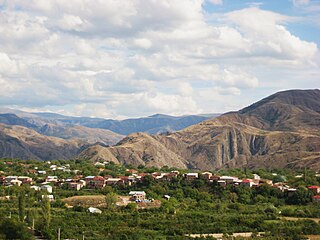
Garni, is a major village in the Kotayk Province of Armenia. It is known for the nearby classical temple. As of the 2011 census, the population of the village is 6,910.

Akunk is a village in the Gegharkunik Province of Armenia. It was founded on the site of a Bronze Age settlement and has a fort dating from the 6th-4th century BC. There are two Tukh Manuk pilgrimage sites in the village as well. West of Akunk is the Klor Dar cyclopean fort.

Alapars is a village in the Kotayk Province of Armenia. The village has 860 dwellings, a school, house of culture, and library. The population is entirely Armenian. Notable natives are director of pump station of the Alapars, USSR multiple medalist Avetik Avetyan, Patriarch Mushegh Aliabertsi (490-561), artist Tatik Saryan, dramatist Melik Kocharyan, folk collector Shavigh Grigoryan, The statesman of RA, Governor of Kotayk Republic of Armenia Kavalenko Shahgaldyan.

Geghhovit is a major village in the Gegharkunik Province of Armenia, founded in the 15th century. The Geghhovit community includes the nearby villages Lernahovit and Nshkhark. In the village is the roofless church of S. Gevorg, built in 1873. The church has some older khachkars built into its walls and is surrounded by a medieval cemetery. There is also a modern small gray basalt Tukh Manuk Chapel in the southern half of the village. Both buildings are located just off the main highway through town.

Lichk is a major village located south of Lake Sevan in the Gegharkunik Province of Armenia. Although the village was officially founded in 1829-30, there are ruins of earlier habitation including the remains of a medieval town. There are also the ruins of the early Tsaghkavank which sit adjacent to the church of S. Astvatsatsin at the hilltop cemetery. Tsaghkavank overlooks the village of Lichk, and the remaining lower walls are cylindrical walls with a very small entry. The reasoning behind this is that one would technically be forced to bow in respect upon entering the church. The church of S. Astvatsatsin is a small basilica with some broken khachkars and gravestones embedded into its walls. It is currently in disrepair as the roof has collapsed. Surrounding the two churches is a 13th-century cemetery with numerous interesting khachkars. Nearby is a cyclopean fort. Between 1950-60, an Aramaic inscription was found nearby.
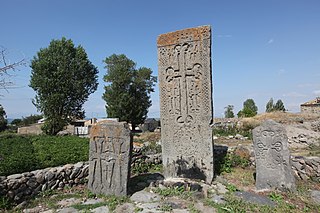
Zolakar, is a major village in the Gegharkunik Province of Armenia. It was founded in 1829 by emigrants from Alashkert. Zolakar is home to the historic churches of Tukh Manuk and Surp Sarkis as well as Bronze Age cemeteries. In the center of the village is a funerary monument.
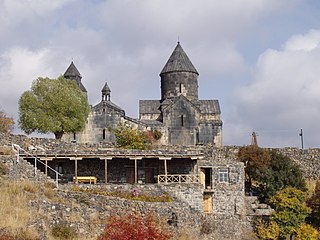
Tegher Monastery is an early 13th-century Armenian monastery and church located on the southeastern slopes of Mount Aragats near the modern village of Tegher, and across the gorge from the village of Byurakan in the Aragatsotn Province of Armenia. It was built for Princess Khatun, the wife of Prince Vache I Vachutian who had purchased the district of Aragatzotn from the Zakarian brothers. The architect Vardapet Aghbayrik designed Tegher and the monasteries of Saghmosavank and Hovhannavank during the 13th century. The monastery survived intact during a time when Mongol invasions plagued the lands.

Jrambar, is a small village in the Aragatsotn Province of Armenia. The local economy is based on the nearby Aparan dam and reservoir, which supplies the capital Yerevan with drinking water. Prior to the construction of the dam, the cultural monuments of the historic village of Zovuni were moved stone-by-stone to higher ground to the east of the reservoir. The Zovuni cemetery sits to the east of the church, across a ravine.
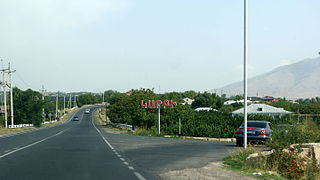
Karbi is a village in the Aragatsotn Province of Armenia situated near the town of Ashtarak. Within the area is a triple-nave basilica of S. Astvatsatsin dated to 1691-93 with an unattached adjacent belfry of 1338. In the village are also S. Gevorg or S. Kiraki church of the 11th to 13th centuries, Tsiranavor, a Tukh Manuk shrine, and "Zargarents Jam" chapel built between the 11th and 13th centuries.

Lusagyugh formerly known as Karanlug, is a village in the Aragatsotn Province of Armenia, located just 1 km northeast of the town of Aparan.

Mastara is a village in the Aragatsotn Province of Armenia. The 5th-century Armenian Church of S. Hovhannes is situated in the northeastern half of the village, while the church of S. Stepanos Nakhava sits on a hilltop to the north. There is also the small medieval Tukh Manuk Church in the village to the southeast.
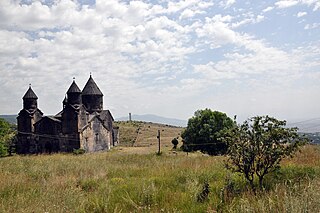
Tegher is a village in the Aragatsotn Province of Armenia on the southern slope of Mount Aragats. It earns its name from the large assortment of healing herbs that are found in the surrounding vicinity.

Yeranos, is a major village in the Gegharkunik Province of Armenia. It has a church of S. Astvatsatsin dating back to 1215, as well as Tukh Manuk and S. Sofia shrines. Following the Gavar-Martuni road, near the chicken farm are the remains of a cyclopean fort.

Zovuni, is an abandoned village in the Aragatsotn Province of Armenia. It was formed during the 1828 by Armenian migrants from the village of Akori in Western Armenia. The villages was abandoned in 1965 and its ruins now lie beneath the Aparan Reservoir.
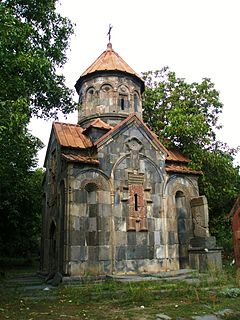
Mashtots Hayrapet is a church located within the village of Garni in the Kotayk Province of Armenia. It was built in the 12th century at the site of what was a pagan shrine. A stone carved from red tufa is situated at the right of the entrance upon a low rock wall. It has on it the design of a bird perched on a floral stem with the rosette of eternity under its tail. The rosette is also a distinctive pagan symbol representing the sun or the moon, symbolizing the eternal cycle of life, death, and rebirth. It is said that because of this pagan symbology, this stone has a connection to the prior shrine.
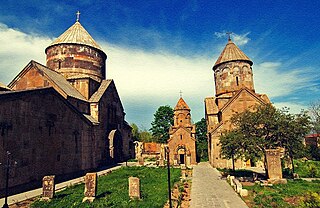
Diocese of Kotayk, is a diocese of the Armenian Apostolic Church covering the Kotayk Province of Armenia. The name is derived from the historic Kotayk canton of Ayrarat province of Armenia Major.

Diocese of Aragatsotn, is a diocese of the Armenian Apostolic Church covering the Aragatsotn Province of Armenia. The name is derived from the historic Aragatsotn canton of Ayrarat province of Kingdom of Armenia.

